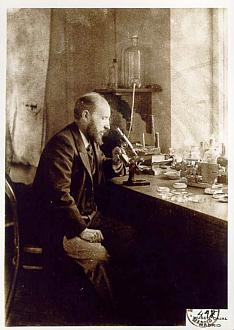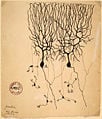Difference between revisions of "Santiago Ramón y Cajal" - New World Encyclopedia
({{Contracted}}) |
|||
| Line 1: | Line 1: | ||
{{Claimed}}{{Contracted}} | {{Claimed}}{{Contracted}} | ||
| − | |||
| − | |||
| − | |||
| − | |||
| − | |||
| − | |||
| − | |||
| − | |||
| − | |||
| − | |||
| − | |||
| − | |||
| − | |||
| − | |||
| − | |||
| − | |||
| − | |||
| − | |||
| − | |||
| − | |||
| − | |||
| − | |||
| − | |||
| − | |||
| − | |||
| − | |||
| − | + | [[Image:Santiago Ramón y Cajal.png|thumb|right150px|Santiago Ramón y Cajal.]] | |
| − | |||
| − | |||
| − | Ramón y Cajal | + | '''Santiago Ramón y Cajal''' ([[May 1]] [[1852]] – [[October 17]] [[1934]]) was a [[Spanish people|Spanish]] [[histology|histologist]], [[physician]], and [[Nobel laureate]]. He is considered to be one of the founders of modern [[neuroscience]]. |
| − | == | + | == Contributions to neuroscience == |
| − | [[Image:Cajal-mi.jpg|234px| | + | [[Image:Cajal-mi.jpg|234px|left]] |
Ramón y Cajal's most famous studies were on the fine structure of the [[central nervous system]]. Cajal used a histological staining technique developed by his contemporary [[Camillo Golgi]]. Golgi found that by treating [[brain]] tissue with a [[silver chromate]] solution, a relatively small number of [[neuron]]s in the brain were darkly stained. This allowed Golgi to resolve in detail the structure of individual neurons and led him to conclude that nervous tissue was a continuous reticulum (or web) of interconnected [[cell (biology)|cell]]s much like those in the [[circulatory system]]. | Ramón y Cajal's most famous studies were on the fine structure of the [[central nervous system]]. Cajal used a histological staining technique developed by his contemporary [[Camillo Golgi]]. Golgi found that by treating [[brain]] tissue with a [[silver chromate]] solution, a relatively small number of [[neuron]]s in the brain were darkly stained. This allowed Golgi to resolve in detail the structure of individual neurons and led him to conclude that nervous tissue was a continuous reticulum (or web) of interconnected [[cell (biology)|cell]]s much like those in the [[circulatory system]]. | ||
| Line 44: | Line 16: | ||
Ramón y Cajal also proposed that the way [[axon]]s grow is via a [[growth cone]] at their ends. He understood that neural cells could sense chemical signals that indicated a direction for growth, a process called [[chemotaxis]]. | Ramón y Cajal also proposed that the way [[axon]]s grow is via a [[growth cone]] at their ends. He understood that neural cells could sense chemical signals that indicated a direction for growth, a process called [[chemotaxis]]. | ||
| − | == | + | ==Ramón y Cajal as artist and writer== |
| − | + | In 1905, he published five science-fictional "Vacation Stories" under the pen name "Dr. Bacteria." | |
| − | + | == Biography == | |
| + | The son of Justo Ramón and Antonia Cajal, Ramón y Cajal was born of Aragonese parents in [[Petilla de Aragón]], an enclave in [[Aragon]], [[Spain]]. As a child he was transferred between many different schools because of his poor behaviour and [[Authoritarianism|anti-authoritarian]] attitude. An extreme example of his precociousness and rebelliousness is his imprisonment at the age of eleven for destroying the town gate with a homemade [[cannon]]. He was an avid painter, artist, and [[gymnast]]. He worked for a time as a shoemaker and barber, and was well known for his pugnacious attitude. | ||
| − | + | Ramón y Cajal attended the medical school of [[Zaragoza]], from which he graduated in 1873. After a competitive examination, he served as a medical [[officer (armed forces)|officer]] in the [[Spanish Army]]. He took part in an expedition to Cuba in 1874-75, where he contracted [[malaria]] and [[tuberculosis]]. After returning to Spain he married Silveria Fañanás García in 1879, with whom he had four daughters and three sons. He was appointed as a [[university]] [[professor]] at [[Universitat de València|Valencia]] in 1881, and in 1883 he received his [[Doctor of Medicine|medical degree]] in [[Madrid]]. He later held professorships in both [[Barcelona]] and Madrid. He was Director of the Zaragoza Museum (1879), Director of the National Institute of Hygiene (1899), and founder of the {{lang|es|''Laboratorio de Investigaciones Biológicas''}} (1922) (later renamed to the {{lang|es|''Instituto Cajal''}}, or [[Cajal Institute]]). He died in Madrid in 1934. | |
| − | |||
| − | |||
==Gallery of drawings by Santiago Ramón y Cajal== | ==Gallery of drawings by Santiago Ramón y Cajal== | ||
| Line 63: | Line 34: | ||
</gallery> | </gallery> | ||
| + | == Selection of published works == | ||
| + | Ramón y Cajal published over 100 scientific works and articles in [[French language|French]], [[Spanish language|Spanish]], and [[German language|German]]. Among his most notable were ''Rules and advices on scientific investigation'', ''Histology'', ''Degeneration and regeneration of the nervous system'', ''Manual of normal histology and micrographic technique'', ''Elements of histology'', ''Manual of general [[pathology|pathological]] [[anatomy]]'', ''New ideas on the fine anatomy of the nerve centres'', ''Textbook on the nervous system of man and the [[vertebrate]]s'', and ''The [[retina]] of vertebrates''. | ||
==See also== | ==See also== | ||
*[[:Category:Spanish Nobel Prize winners]] | *[[:Category:Spanish Nobel Prize winners]] | ||
Revision as of 15:54, 19 June 2007
Santiago Ramón y Cajal (May 1 1852 – October 17 1934) was a Spanish histologist, physician, and Nobel laureate. He is considered to be one of the founders of modern neuroscience.
Contributions to neuroscience
Ramón y Cajal's most famous studies were on the fine structure of the central nervous system. Cajal used a histological staining technique developed by his contemporary Camillo Golgi. Golgi found that by treating brain tissue with a silver chromate solution, a relatively small number of neurons in the brain were darkly stained. This allowed Golgi to resolve in detail the structure of individual neurons and led him to conclude that nervous tissue was a continuous reticulum (or web) of interconnected cells much like those in the circulatory system.
Using Golgi's method, Ramón y Cajal reached a very different conclusion. He postulated that the nervous system is made up of billions of separate neurons and that these cells are polarized. Rather than forming a continuous web, Cajal suggested that neurons communicate with each other via specialized junctions called "synapses", a term that was coined by Sherrington in 1897. This hypothesis became the basis of the neuron doctrine, which states that the individual unit of the nervous system is a single neuron. Electron microscopy later showed that a plasma membrane completely enclosed each neuron, supporting Cajal's theory, and weakening Golgi's reticular theory.
However, with the discovery of electrical synapses (gap junctions: direct junctions between nerve cells), some have argued that Golgi was at least partially correct. For this work Ramón y Cajal and Golgi shared the Nobel Prize in Physiology or Medicine in 1906.
Ramón y Cajal also proposed that the way axons grow is via a growth cone at their ends. He understood that neural cells could sense chemical signals that indicated a direction for growth, a process called chemotaxis.
Ramón y Cajal as artist and writer
In 1905, he published five science-fictional "Vacation Stories" under the pen name "Dr. Bacteria."
Biography
The son of Justo Ramón and Antonia Cajal, Ramón y Cajal was born of Aragonese parents in Petilla de Aragón, an enclave in Aragon, Spain. As a child he was transferred between many different schools because of his poor behaviour and anti-authoritarian attitude. An extreme example of his precociousness and rebelliousness is his imprisonment at the age of eleven for destroying the town gate with a homemade cannon. He was an avid painter, artist, and gymnast. He worked for a time as a shoemaker and barber, and was well known for his pugnacious attitude.
Ramón y Cajal attended the medical school of Zaragoza, from which he graduated in 1873. After a competitive examination, he served as a medical officer in the Spanish Army. He took part in an expedition to Cuba in 1874-75, where he contracted malaria and tuberculosis. After returning to Spain he married Silveria Fañanás García in 1879, with whom he had four daughters and three sons. He was appointed as a university professor at Valencia in 1881, and in 1883 he received his medical degree in Madrid. He later held professorships in both Barcelona and Madrid. He was Director of the Zaragoza Museum (1879), Director of the National Institute of Hygiene (1899), and founder of the Laboratorio de Investigaciones Biológicas (1922) (later renamed to the Instituto Cajal, or Cajal Institute). He died in Madrid in 1934.
Gallery of drawings by Santiago Ramón y Cajal
Selection of published works
Ramón y Cajal published over 100 scientific works and articles in French, Spanish, and German. Among his most notable were Rules and advices on scientific investigation, Histology, Degeneration and regeneration of the nervous system, Manual of normal histology and micrographic technique, Elements of histology, Manual of general pathological anatomy, New ideas on the fine anatomy of the nerve centres, Textbook on the nervous system of man and the vertebrates, and The retina of vertebrates.
See also
- Category:Spanish Nobel Prize winners
ReferencesISBN links support NWE through referral fees
- Ramón y Cajal, Santiago (1937). Recuerdos de mi Vida. Cambridge: MIT Press. ISBN 8420622907.
- Ramón y Cajal, Santiago [1897] (1999). Advice for a Young Investigator, translated by Neely Swanson and Larry W. Swanson, Cambridge: MIT Press. ISBN 0262681501.
- Everdell, William R. (1998). The First Moderns. Chicago: University of Chicago Press. ISBN 0226224805.
External links
- The Nobel Prize in Physiology or Medicine 1906
- Life and discoveries of Cajal
- Ramon y Cajal, an Aragonese Nobel Prize
Credits
New World Encyclopedia writers and editors rewrote and completed the Wikipedia article in accordance with New World Encyclopedia standards. This article abides by terms of the Creative Commons CC-by-sa 3.0 License (CC-by-sa), which may be used and disseminated with proper attribution. Credit is due under the terms of this license that can reference both the New World Encyclopedia contributors and the selfless volunteer contributors of the Wikimedia Foundation. To cite this article click here for a list of acceptable citing formats.The history of earlier contributions by wikipedians is accessible to researchers here:
The history of this article since it was imported to New World Encyclopedia:
Note: Some restrictions may apply to use of individual images which are separately licensed.





